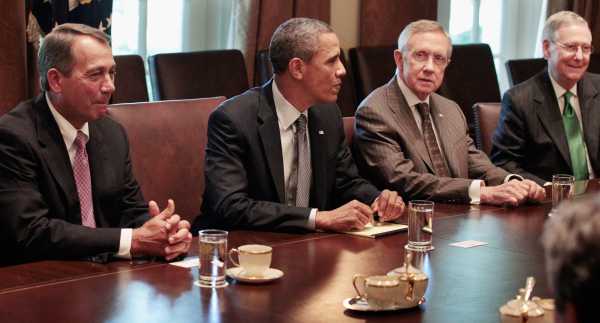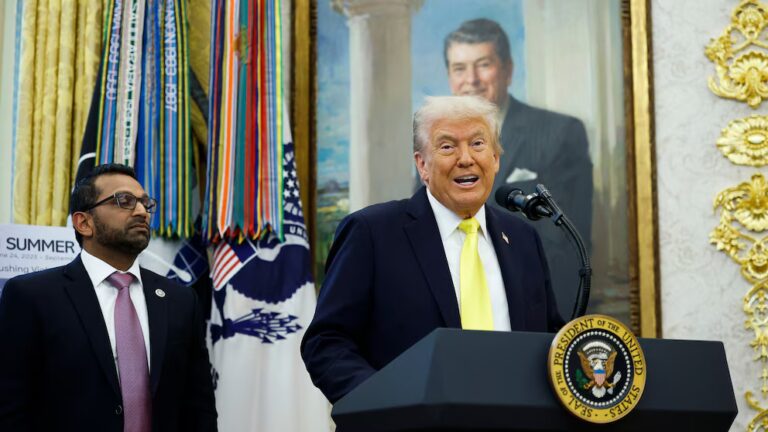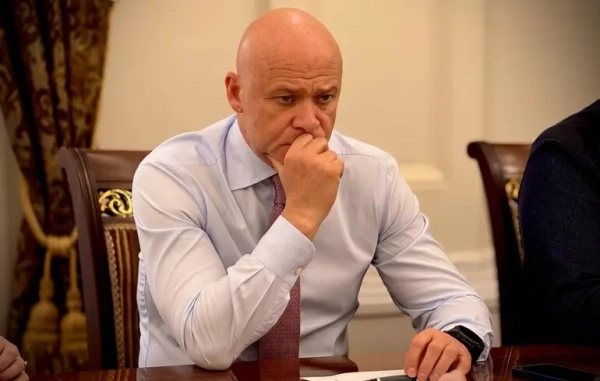
Li Zhou is a politics reporter at Vox, where she covers Congress and elections. Previously, she was a tech policy reporter at Politico and an editorial fellow at the Atlantic.
If the 2023 debt ceiling standoff feels familiar, that’s because it is.
This Wednesday, President Joe Biden and House Speaker Kevin McCarthy will meet to address a conflict that lawmakers also directly confronted in 2011. That year, much like this one, Republicans had just retaken the House while Democrats held the Senate and White House. Then, as now, the GOP was balking on an increase to the debt ceiling unless they got the spending cuts they demanded.
Biden and McCarthy’s meeting is poised to set the stage for what could be another tense stalemate with calamitous implications for the country’s economy. As of late January, the US has already “hit” its debt ceiling, or the amount it’s able to borrow, and the Treasury Department is employing what’s known as “extraordinary measures” to cover the country’s bills. Those efforts are expected to take the US through early June, when it could risk an actual default on its debt. Should the US default, that would have disastrous economic fallout including higher interest rates, millions of job losses, and a major hit to the country’s GDP.
In 2011, Republicans’ unwillingness to back down on spending cuts almost led the US to intentionally go over the brink for the first time, a near miss that contributed to the country’s credit rating getting downgraded by Standard & Poor’s. Back then, markets plummeted, interest rates increased, and the country’s borrowing costs went up by $1.3 billion. That same scenario could play out once again, potentially in an even more chaotic fashion.
“There is considerable deja vu,” said David Kamin, an economic adviser for the Obama administration who played a key role in 2011 talks.
Broadly, that standoff revealed that going up to the deadline — even if the US didn’t default — could have serious consequences for the economy. Additionally, it had major contradictory lessons for Republicans and Democrats that could inform how they approach the issue this time around and lead them to view the risks differently.
“Obama learned the lesson: Don’t negotiate. And Vice President Biden was right in the middle of those negotiations,” said Jason Furman, an economist involved in the 2011 talks on behalf of the White House. “And he has no eagerness to jump back in them because he saw what they were like, saw that nothing good came out of them.”
Republicans, however, viewed the gains they made in 2011 as an important victory, even though many of them were later undone.
“I think one of the takeaways was that running this play worked, you know, we were able to actually achieve something and use this moment for leverage,” said Brendan Buck, a staffer to House Speaker John Boehner in 2011. “The question is whether you can keep running that same play over and over again and still get an outcome.”
Lawmakers saw the impact last-minute debt ceiling negotiations could have on the economy
In 2011, the US came within 72 hours of actually defaulting on its debt, only narrowly averting it.
That year, after talks between the White House and House Republicans imploded, congressional leaders helped put together a deal that could get through both chambers. Ultimately, lawmakers approved this legislation — which addressed demands from both parties — on the day that the Treasury Department believed all “extraordinary measures” would be exhausted.
The legislation, known as the Budget Control Act of 2011, initially increased the debt ceiling by $900 billion and guaranteed a similar amount in long-term savings across defense and non-defense expenditures. It also set up a super committee of lawmakers who were tasked with finding a set amount of additional spending cuts by late November, or automatic spending cuts would be triggered across the board.
By the time the bill passed, however, some of the economic damage was already done. Because the US was so close to default, the stock market had already dipped and the cost of borrowing had increased for the government as well. Higher borrowing costs effectively mean the government has to pay more for loans and has fewer resources to spend on public investments like infrastructure. Additionally, in part due to the brinksmanship involved, the credit rating agency S&P downgraded the country’s credit rating for the first time in US history, signaling to potential buyers that taking on US debt wasn’t as safe as it once was, and undercutting global trust in the country’s economy.
The outcome in 2011 revealed that even getting close to a default was dangerous and had a problematic impact on the economy, experts say. “This is an entirely human-made crisis that adds extra cost to the taxpayer, that can lead to market volatility, and that’s totally avoidable,” said David Vandivier, a former Treasury Department official.
“Repeating it doesn’t make sense,” emphasized Furman.
That warning may go unheeded, however. While Democrats have argued that the debt ceiling — which covers debts the US government has already incurred — should be separate from negotiations on the budget and spending, Republicans have indicated that they’re eager to use this opportunity to secure possible savings, even if it incurs risks that became apparent in 2011.
What Democrats learned
This year, Biden has been clear that he isn’t interested in negotiating with Republicans over the debt limit, an approach that’s informed by the negative experiences in 2011, according to experts who were there.
“I will not let anyone use the full faith and credit of the United States as a bargaining chip,” Biden said in a recent speech.
Democrats have largely taken this approach since 2011 because of how they felt burned that year. Weeks of negotiations with House Republicans ultimately collapsed after the Obama administration offered spending cuts in exchange for higher taxes on wealthy individuals and corporations. The administration argued that it provided concessions to entitlement spending that Republicans had demanded, but the GOP was uninterested in a deal involving more taxes. By the time the negotiations fell apart, the US was nearing default.
“Those negotiations not only failed but proved so disruptive to financial markets, and so personally scarring, that Obama and his team emerged from the ordeal determined never to repeat it,” Ron Brownstein wrote in the Atlantic.
Since then, Democrats have demanded a clean increase to the debt ceiling that doesn’t include any trade-offs. They’ve argued that negotiations on spending can happen separately but that they should not be tied to the debt ceiling.
In 2013, for example, the Obama administration refused to negotiate with House Republicans who called for cuts to the Affordable Care Act in exchange for their passage of spending bills and an increase to the debt ceiling. That position resulted in Republicans approving a clean increase, which they did multiple times after that as well.
“The key takeaway from 2011 is you can’t negotiate with hostage takers. End of story,” said Jim Manley, a former staffer to Sen. Harry Reid.
What Republicans learned
Despite the economic fallout it caused, and the fact that much of the legislation that was negotiated was undone, Republicans note that the 2011 standoff resulted in some wins, and a chance to force a conversation about fiscal issues that many members ran on. That outcome notably offers certain members of the party a case to stage a repeat.
“Some Republicans look back at 2011 and see it as a successful use of the debt limit to extract the biggest spending cut in decades,” said Brian Riedl, a former economic policy staffer to Sen. Rob Portman.
In the end, Republicans touted that they secured spending cuts, and did so without the addition of new taxes. In total, the agreement contained $2.1 trillion in cuts to be implemented over 10 years, which was comparable to the debt increase.
Some of these cuts failed to materialize, however, because lawmakers have since passed bills that lifted certain discretionary spending caps. Kumar notes that one big lesson was that it’s better to focus on spending cuts that can be guaranteed in the short term versus longer-term ones that could be unraveled by future Congresses.
And as much as the 2011 fight was about these savings, it was also about Republicans confronting a Democratic administration on spending. Many Republicans in the House at the time had been elected as part of the 2010 Tea Party wave, and saw fiscal responsibility as one of the chief issues they were brought to Congress to focus on, compelling them to dig in even further. Conservatives could again use the debt ceiling fight to make a point about their commitment to “responsible” spending this year, even though they haven’t put up the same opposition when those increases were made under a Republican administration.
“I think the Republicans’ takeaway, in some cases, is that this is basically the only time, every year or two, that we even have a conversation about fiscal policy and spending, and our large and growing debt burden,” Shai Akabas, an economic policy expert at the Bipartisan Policy Center, said.
There are differences and similarities with 2011
Although there are notable similarities between 2011 and 2023, there are also key differences that could make this year’s debt ceiling even uglier and riskier than it was before.
“The politics in the House are just a lot tougher now than they ever were,” said Buck. “So you just can’t have that same level of confidence that they would never let something bad happen.”
Relative to 2011, House Republicans have an even narrower margin this term, giving the more extreme members of their conference outsize sway over how they approach bills and issues like the debt ceiling. Were McCarthy to pursue either a clean debt ceiling increase or a compromise measure that didn’t satisfy conservatives, he could face a challenge to his speakership, for instance. A fear of that challenge could lead McCarthy to follow a strategy that speaks to more of those members’ demands, an approach that’s likely to face opposition from Democrats.
“I should say, the conditions for anything good coming out of this now, other than the increase in the debt limit, are even less favorable than they were in 2011,” said Furman, regarding what Democrats could get out of negotiations.
Political experts told Vox that, much like in 2011, the resolution will involve concessions that enable Republicans to at least claim that they got something.
“We might end up with something that’s more modest but that Republicans can sell back to their voters as having achieved something in the fight. Everybody needs something to save face,” said Riedl. At this point, it’s not entirely clear what that could entail since Republicans haven’t put forth specific demands just yet.
In 2011, House Republicans had a broad requirement of matching every dollar of debt ceiling increase with a commensurate cut. This year, McCarthy has said he is interested in reducing spending outside of Medicare and Social Security, but has not laid out what those cuts will include. Wednesday’s meeting, ultimately, is likely just the first of many discussions that will set the tone for how this showdown could go this time around.
Sourse: vox.com






